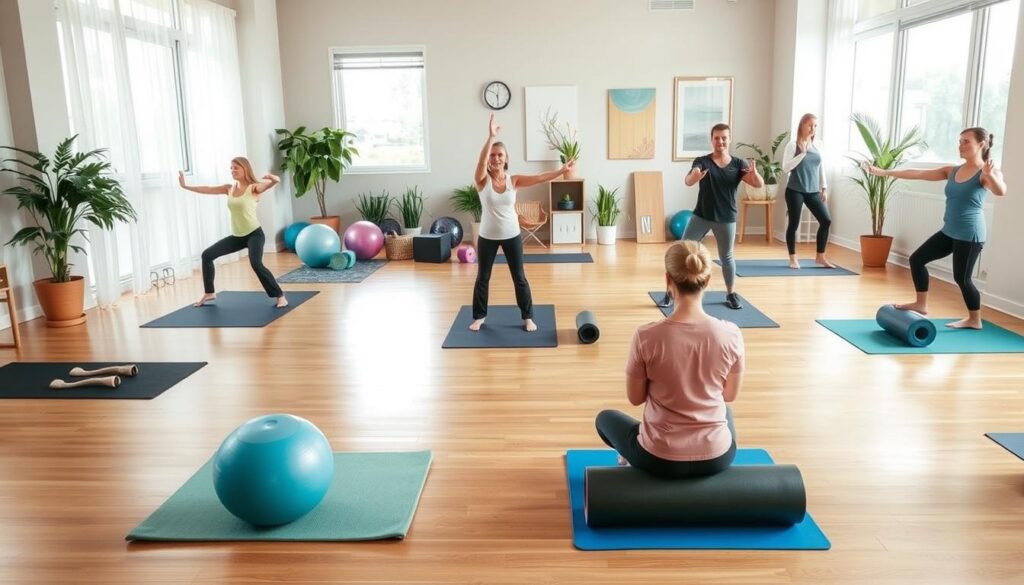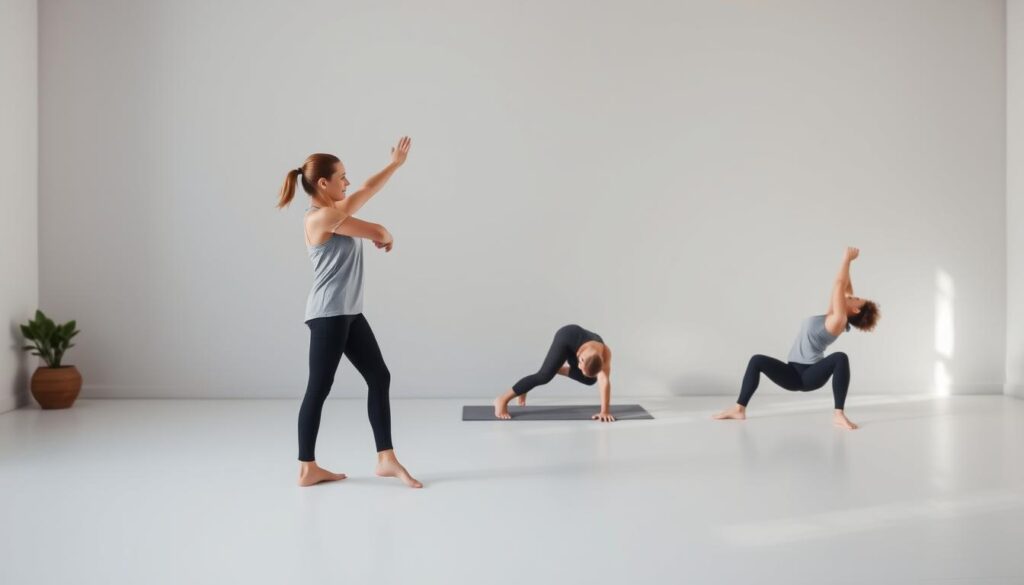You remember when moving felt effortless. Now, creaky knees and stiff shoulders make every step feel like a negotiation. But what if I told you that gentle movement could be your ally – not your enemy? I learned this truth the hard way after watching my mom struggle with arthritis, her walker collecting dust while her spirit dimmed.
The right exercises can rebuild trust between you and your body. Studies show that consistent, mindful activity strengthens the muscles supporting vulnerable joints while improving cardiovascular function. This isn’t about pushing through pain – it’s about rediscovering what your body can still achieve.
Imagine waking up with less stiffness. Picture climbing stairs without wincing. These possibilities become real when you explore gentle exercises recommended by physical therapists. Water-based activities and modified strength training offer surprising intensity without the pounding impact of traditional workouts.
Your journey matters more than your pace. Every small effort accumulates – better blood sugar control, improved sleep patterns, even that mental clarity that comes from steady movement. Your joints might never be 20 again, but they can become resilient partners in your health story.
Key Takeaways
- Gentle movement strengthens joint-supporting muscles while protecting sensitive areas
- Water exercises and cycling provide cardio benefits without impact stress
- Consistent activity improves blood pressure, cholesterol, and diabetes risk
- Modified routines build confidence in your body’s capabilities
- Endorphins from exercise naturally ease stress and improve mood
- Progress depends on consistency, not intensity
Understanding Joint Pain and the Benefits of Low-Impact Exercises
Many assume joint discomfort means avoiding movement entirely. This misconception often worsens stiffness and reduces mobility over time. Three primary conditions account for most joint-related challenges – each requiring tailored approaches to physical activity.
Common Causes and Conditions Impacting Your Joints
Osteoarthritis wears down cartilage in knees, hips, and hands, turning simple tasks into painful struggles. Rheumatoid arthritis differs – it’s an autoimmune response causing inflammation and fatigue beyond just joint swelling. Bursitis targets the fluid-filled cushions around shoulders and elbows, creating sharp pain during reaching motions.
| Condition | Affected Areas | Key Symptoms |
|---|---|---|
| Osteoarthritis | Knees, hips, hands | Morning stiffness, grinding sensations |
| Rheumatoid Arthritis | Joints, whole body | Swelling, fever, symmetrical pain |
| Bursitis | Shoulders, elbows, hips | Localized tenderness, limited motion |
Why Movement Matters for Joint Care
Inactivity weakens the muscles supporting your skeletal frame, accelerating damage. Gentle activities like swimming or cycling maintain flexibility while protecting sensitive areas. They improve blood flow to joints without ground-impact strain.
Consult your doctor to identify specific limitations. Modified movements build strength gradually – think leg lifts instead of lunges. Over time, this approach reduces inflammation and restores confidence in your body’s capabilities.
Low-Impact Workouts for Beginners with Joint Pain
Your journey to stronger joints begins with activities that respect your body’s limits while challenging your capabilities. These carefully selected methods build endurance without strain, letting you rediscover the joy of motion.
Step Smart With Walking Variations
Slip on supportive shoes and step outside – the world becomes your gym. Begin with flat routes, focusing on posture: shoulders relaxed, chin parallel to the ground. Gradually add inclines or wrist weights to boost intensity as your stamina improves.

Water’s Weightless Workouts
Submerge yourself in aquatic therapy where resistance meets relief. Whether doing laps or water aerobics, each movement strengthens muscles while floating reduces pressure on hips and knees. Alternate strokes to engage different areas – breaststroke works the chest, while backstroke tones shoulders.
Pedal and Glide for Joint Care
Stationary bikes let you control resistance levels, protecting knees from pavement pounding. Elliptical machines offer similar advantages – their smooth motion mimics running without impact. “The elliptical became my pain-free cardio solution,” shares Martha, 58, after knee replacement surgery.
Tai chi deserves special mention – this flowing martial art enhances balance through controlled poses. Its meditative pace strengthens core muscles crucial for joint stability, proving effective in multiple arthritis studies.
Techniques for Maintaining Proper Form and Preventing Injuries
Proper alignment transforms exercise from strain to sustainable progress. Your focus on precise motion patterns protects vulnerable areas while maximizing fitness benefits. Let’s explore how smart technique choices keep your routine both effective and safe.

Fundamental Form Tips and Equipment Advice
Your equipment setup acts as your first line of defense. On stationary bikes, adjust the seat so your knees stay slightly bent at full pedal extension. Handlebars should sit high enough to prevent slouching – imagine balancing a book between your shoulder blades.
Rowing machines demand particular attention. Begin with bent knees and vertical shins, pushing through your heels before leaning back. “Reverse the sequence when returning – arms first, then torso, finally legs,” advises physical therapist Dr. Elena Martinez. This protects your lower back from unnecessary stress.
Guidelines for Safe Strength Training and Resistance Workouts
Resistance bands offer joint-friendly alternatives to heavy weights. Anchor them securely and maintain tension throughout each movement. For upper body exercises, keep elbows slightly bent during presses to avoid locking joints.
Bodyweight squats teach proper knee alignment. Track your kneecaps over middle toes during descent, stopping before discomfort arises. Muscle fatigue should feel like trembling, not sharp pain. Always warm up with arm circles and gentle leg swings to prepare connective tissues.
Consult your doctor or fitness professional when introducing new exercises. They can modify movements based on your unique needs, ensuring your form supports rather than strains your body.
Integrating Low-Impact Workouts into Your Daily Routine
Creating sustainable habits starts with alignment between your aspirations and physical reality. Begin by scheduling movement sessions like important meetings – non-negotiable but flexible in execution. Pair activities with existing routines: stretch during morning coffee commercials or practice balance exercises while brushing teeth.
Building Sustainable Movement Patterns
Start with three 10-minute sessions weekly – achievable targets build confidence. Use phone reminders or sticky notes as visual cues until the habit sticks. Mix aquatic sessions with land-based activities to engage different muscle groups while keeping things fresh.
Consult your healthcare provider to design a weekly plan that accommodates flare-ups. “Consistency matters more than duration early on,” notes rehabilitation specialist Dr. Karen Lee. Track energy levels and stiffness in a notebook to identify optimal workout times.
Recognizing Your Body’s Feedback
Muscle warmth signals healthy effort – joint throbbing demands immediate adjustment. Swap problematic moves using arthritis-approved modifications. Celebrate completing a full week of planned activities as triumphantly as hitting longer durations.
Rest days prevent overtraining – alternate activity types rather than skipping entirely. Gentle yoga on recovery days maintains mobility without strain. Remember: progress manifests in easier shoe tying before appearing on scales.
Conclusion
Your body thrives on smart movement. Choosing gentle exercises strengthens joints while improving overall health. Research confirms that regular physical activity reduces stiffness and enhances mobility for those managing chronic conditions.
Consistency beats intensity every time. Start with short sessions approved by your doctor, focusing on fluid motions that maintain flexibility. Water-based routines and modified strength training offer proven ways to stay active without aggravating sensitive areas.
Track small victories – easier stair climbing or longer walks with friends. These milestones reveal your progress better than any scale. Pair exercise with proper rest to let joints recover while building lasting strength.
Remember: movement is medicine. Quality matters more than quantity when designing your routine. With patience and the right approach, you’ll discover how purposeful activity restores confidence in your body’s capabilities.

